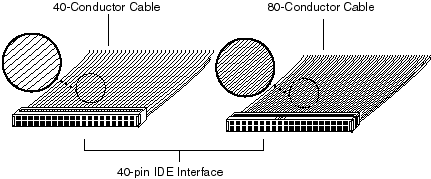Ultra ATA/66 Technology Review
by Anand Lal Shimpi on February 28, 1999 4:39 PM EST- Posted in
- Storage
The Specification
Ultra ATA/66 (you'll also hear it referred to as Ultra DMA/66 or Fast ATA-2) allows for a theoretical maximum burst transfer rate of 66.6MB/s, double the maximum of Ultra ATA/33's 33.3MB/s. Another change brought about during the introduction of the Ultra ATA/33 specification was the idea of Cyclical Redundancy Check (CRC) which is something that you've all probably heard of in one form or another at sometime during your computing experience. Basically, before any burst transfers take place both the hard drive and host will calculate what should make it through the transfer and then afterwards the host sends a signal back to the hard drive telling it what actually made it over during the transfer. If the two numbers don't match up then the process is automatically repeated until it is completed successfully. Ultra ATA/66 brings the same CRC feature that Ultra ATA/33 brought to the table, couples it with its 66.6MB/s theoretical burst transfer rate, and adds yet another new feature to the growing list: improved data integrity.
Hard Drive Data Transfer Protocol Comparison |
||||
Standard |
Theoretical Max. Burst Transfer Rate | Cable Requirement | Conductors | CRC Enabled |
| PIO Mode 0 | 3.3 MB/s |
40-pin |
40 | No |
| PIO Mode 1 | 5.2 MB/s | 40-pin | 40 | No |
| PIO Mode 2 | 8.3 MB/s | 40-pin | 40 | No |
| DMA Mode 1 (PIO Mode 3) | 11.1 MB/s | 40-pin | 40 | No |
| DMA Mode 2 (PIO Mode 4) | 16.6 MB/s | 40-pin | 40 | No |
| Ultra ATA/33 (Ultra DMA Mode 2) | 33.3 MB/s | 40-pin | 40 | Yes |
| Ultra ATA/66 (Ultra DMA Mode 4) | 66.6 MB/s | 40-pin | 80 | Yes |
While CRC increased the integrity of transferred data, after approaching burst speeds of 33.3MB/s we begin to truly stress the capabilities of conventional 40-pin IDE cables, and there is a considerable increase in signal "leakage" at the more aggressive timings. The 44.4MB/s mark (Ultra ATA mode 3) is the first marker of unreliability when using conventional cables during burst transfers, what happens is that the data loses its integrity between the hard drive and host controller due to increased timings that the cables were never intended to deal with. At the same time, a standard that required a completely new cable design (such as something similar to what SCSI devices use to achieve their 40MB/s+ burst transfer rates) would never be pursued by the market since that would mean zero backwards compatibility, the solution? Reuse the same cables with a new twist, twice as many conductors.
The Ultra ATA/66 specification calls for the same 40-pin IDE cables that all IDE/EIDE hard drives have used for years now however, in order to take advantage of the specification's higher burst transfer rates the cable specification had to be modified to take into account the more aggressive timing signals that would be transferred over the cables. The result was the same 40-pin IDE cable with twice as many ground lines present in the cable to act as shields between the lines that actually carry live signals back and forth. By doing this we maintain backwards compatibility with all older IDE/EIDE hard drives and ensure data integrity during burst transfers exceeding 33.3MB/s.

Copyright 1999 Western
Digital
Taking Advantage of Ultra ATA/66
What do you need to take advantage of Ultra ATA/66? There are 4 basic requirements:
- Ultra ATA/66 support in your motherboard's chipset, currently the only available chipset that supports Ultra ATA/66 is the VIA Apollo Pro+. The Apollo Pro+ or any VIA chipsets for that matter can take advantage of Ultra ATA/66 as long as they make use of VIA's VT82C686A Super South Bridge Controller, which is a bit more expensive than the VT82C596A Mobile South Bridge Controller that most motherboard manufacturers opt to use. AnandTech has yet to see any Slot-1 Apollo Pro+ boards in the lab that use the updated South Bridge Controller, however AnandTech's MVP4 sample did have the controller and that is what was used in the tests. Intel's upcoming Camino chipset should support Ultra ATA/66.
- Operating System support for DMA transfers via a DMA device driver. Windows 9x and Windows NT currently support DMA transfers by checking the Enable DMA box under Windows Device Manager. BIOS support for Ultra DMA Mode 4 (Ultra ATA/66) is also encouraged, although using software utilities you can enable the settings without BIOS support.
- A 40-pin 80-conductor cable, with a standard 40-pin 40-conductor cable Ultra ATA/66 transfer modes will be disabled and you'll basically have an Ultra ATA/33 hard drive. Ultra ATA/66 drives are backwards compatible with older host controllers, you can use them on non-Ultra ATA/33 controllers however you won't get Ultra ATA/66 performance out of the drives. Western Digital's 13GB drive did not ship with any 80-conductor cables, and even required that Ultra ATA/66 support be turned on via their own utility available on their web site.
- Finally, you need an Ultra ATA/66 drive to complete the requirements, currently IBM (www.storage.ibm.com) and Western Digital (www.westerndigital.com) have hard drives that are Ultra ATA/66 compliant.










0 Comments
View All Comments